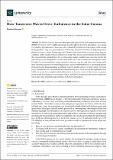Files in this item
How transverse waves drive turbulence in the solar corona
Item metadata
| dc.contributor.author | Howson, Thomas | |
| dc.date.accessioned | 2022-02-15T16:30:18Z | |
| dc.date.available | 2022-02-15T16:30:18Z | |
| dc.date.issued | 2022-02-15 | |
| dc.identifier | 277844406 | |
| dc.identifier | c2bfac7a-fe69-4fdd-aada-e7df510b5671 | |
| dc.identifier | 000764299100001 | |
| dc.identifier | 85125110312 | |
| dc.identifier.citation | Howson , T 2022 , ' How transverse waves drive turbulence in the solar corona ' , Symmetry , vol. 14 , no. 2 , 384 . https://doi.org/10.3390/sym14020384 | en |
| dc.identifier.issn | 2073-8994 | |
| dc.identifier.uri | https://hdl.handle.net/10023/24889 | |
| dc.description | Funding: This research was funded by the European Research Council grant number 647214. | en |
| dc.description.abstract | Oscillatory power is pervasive throughout the solar corona, and magnetohydrodynamic (MHD) waves may carry a significant energy flux throughout the Sun’s atmosphere. As a result, over much of the past century, these waves have attracted great interest in the context of the coronal heating problem. They are a potential source of the energy required to maintain the high-temperature plasma and may accelerate the fast solar wind. Despite many observations of coronal waves, large uncertainties inhibit reliable estimates of their exact energy flux, and as such, it remains unclear whether they can contribute significantly to the coronal energy budget. A related issue concerns whether the wave energy can be dissipated over sufficiently short time scales to balance the atmospheric losses. For typical coronal parameters, energy dissipation rates are very low and, thus, any heating model must efficiently generate very small-length scales. As such, MHD turbulence is a promising plasma phenomenon for dissipating large quantities of energy quickly and over a large volume. In recent years, with advances in computational and observational power, much research has highlighted how MHD waves can drive complex turbulent behaviour in the solar corona. In this review, we present recent results that illuminate the energetics of these oscillatory processes and discuss how transverse waves may cause instability and turbulence in the Sun’s atmosphere. | |
| dc.format.extent | 23 | |
| dc.format.extent | 3057115 | |
| dc.language.iso | eng | |
| dc.relation.ispartof | Symmetry | en |
| dc.subject | MHD oscillations | en |
| dc.subject | Coronal heating | en |
| dc.subject | MHD turbulence | en |
| dc.subject | QA Mathematics | en |
| dc.subject | QB Astronomy | en |
| dc.subject | QC Physics | en |
| dc.subject.lcc | QA | en |
| dc.subject.lcc | QB | en |
| dc.subject.lcc | QC | en |
| dc.title | How transverse waves drive turbulence in the solar corona | en |
| dc.type | Journal item | en |
| dc.contributor.sponsor | European Research Council | en |
| dc.contributor.institution | University of St Andrews. Applied Mathematics | en |
| dc.identifier.doi | 10.3390/sym14020384 | |
| dc.description.status | Peer reviewed | en |
| dc.identifier.url | https://www.mdpi.com/2073-8994/14/2/384 | en |
| dc.identifier.grantnumber | 647214 | en |
This item appears in the following Collection(s)
Items in the St Andrews Research Repository are protected by copyright, with all rights reserved, unless otherwise indicated.

